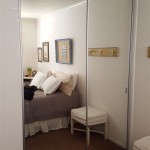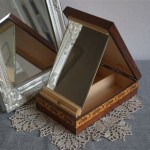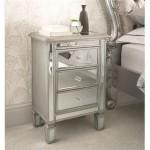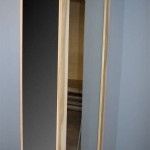Elevating Dining Room Aesthetics: The Strategic Use of Mirror Design
Mirrors, beyond their functional role in reflection, serve as powerful design elements capable of transforming interior spaces. In dining rooms, mirrors strategically employed can significantly enhance the aesthetic appeal, create a sense of spaciousness, and amplify the existing lighting. This article explores the various ways mirrors can be incorporated into dining room designs, focusing on their practical benefits and aesthetic contributions.
Enhancing Spaciousness and Light
One of the primary advantages of incorporating mirrors into a dining room design is their ability to visually expand the space. Mirrors create an illusion of greater depth, which is particularly beneficial in smaller dining areas or rooms with limited natural light. When strategically placed, mirrors can reflect existing light sources, both natural and artificial, effectively brightening the entire room. This can result in a more welcoming and inviting atmosphere.
The perceived increase in space is achieved through the mirror's reflection of the room's contents. This reflection essentially doubles the visual information available, leading the eye to perceive a larger area. Consider placing a large mirror on a wall opposite a window. This will not only reflect the natural light streaming in but also the outdoor landscape, effectively bringing the outdoors inside and creating a connection with nature. In rooms with limited windows, mirrors can be used to reflect artificial light sources, such as chandeliers or wall sconces, to create a similar effect.
The size and placement of the mirror are crucial factors in achieving the desired effect. A large, floor-to-ceiling mirror will maximize the perceived size of the room, while smaller mirrors can be used to highlight specific areas or create visual interest. When positioning mirrors, it is important to consider what they will be reflecting. Avoid reflecting cluttered areas or unattractive views, as this will detract from the overall aesthetic. Instead, focus on reflecting visually appealing elements, such as artwork, furniture, or architectural details.
Furthermore, the frame of the mirror plays a significant role in its visual impact. A minimalist frame will blend seamlessly into the background, allowing the reflective surface to take center stage. Conversely, a more ornate frame can add a touch of elegance and sophistication to the room. The choice of frame should complement the overall style of the dining room and the existing furniture.
Creating Focal Points and Visual Interest
Mirrors can also be used to create focal points within the dining room, drawing the eye and adding visual interest. A strategically placed mirror can highlight a particular feature, such as a fireplace, a piece of artwork, or an architectural detail. This can help to create a sense of balance and harmony within the room.
Instead of a single large mirror, consider using a grouping of smaller mirrors to create a gallery wall effect. This can be a visually striking way to add texture and depth to the room. Varying the sizes, shapes, and frame styles of the mirrors can further enhance the visual appeal. When creating a mirror gallery wall, it is important to consider the overall composition and ensure that the mirrors are arranged in a balanced and cohesive manner.
Another option is to incorporate a mirrored accent wall. This involves covering an entire wall with mirrors, creating a dramatic and impactful statement. A mirrored accent wall can be particularly effective in smaller dining rooms, as it will visually double the size of the space and create a sense of grandeur. When using a mirrored accent wall, it is important to ensure that the surrounding furniture and decor are carefully chosen to complement the mirrored surface.
Mirrored furniture, such as a mirrored sideboard or buffet, can also add a touch of glamour and sophistication to the dining room. Mirrored furniture reflects the surrounding light and colors, creating a shimmering and ethereal effect. This can be particularly effective in dining rooms with a more formal or luxurious aesthetic. When incorporating mirrored furniture, it is important to consider the overall balance of the room and avoid overusing mirrored elements, as this can create a visually overwhelming effect.
Selecting the Right Mirror Style and Placement
The selection of the appropriate mirror style for a dining room should be based on the existing design elements and the intended aesthetic. Consider the overall style of the dining room, whether it is traditional, modern, minimalist, or eclectic. The mirror should complement the existing furniture, décor, and architectural features.
For a traditional dining room, a mirror with an ornate frame, such as a gilded or carved wood frame, may be appropriate. This can add a touch of elegance and sophistication to the room. In a modern dining room, a mirror with a minimalist frame, such as a metal or frameless mirror, may be a better choice. This will create a clean and contemporary look.
In addition to the frame style, consider the shape and size of the mirror. A rectangular mirror is a classic choice that can be used in a variety of settings. A round or oval mirror can add a softer and more feminine touch to the room. The size of the mirror should be proportionate to the size of the wall on which it will be placed. A mirror that is too small will look insignificant, while a mirror that is too large can overwhelm the space.
Proper placement is paramount. Consider the height at which the mirror is hung. It should be positioned at a height that allows people to comfortably see their reflection. A good rule of thumb is to hang the mirror so that the center is at eye level. Also, consider the angle at which the mirror is placed. Tilting the mirror slightly can help to reflect more light and create a more flattering reflection.
Finally, consider the maintenance requirements of the mirror. Mirrors can be prone to smudges and fingerprints, so it is important to choose a mirror that is easy to clean. Regularly cleaning the mirror will help to keep it looking its best and ensure that it continues to enhance the aesthetic appeal of the dining room.
In summary, the strategic integration of mirrors in dining room design offers a multitude of benefits, from enhancing spaciousness and light to creating focal points and visual interest. By carefully considering the size, shape, frame style, and placement of mirrors, homeowners and designers can effectively transform their dining rooms into more inviting and visually appealing spaces.

How To Use Wall Sconces Design Tips Ideas Mirror Dining Room Walls Decor

5 Dining Room Mirrors A Must Have For Every Home
:strip_icc()/dining-room-mirror-ideas-1-ashley-montgomery-b90b98cab74443e9ab4f9d5e9f6ac2d2.jpeg?strip=all)
17 Dining Room Mirror Ideas That Ll Dress Up Your Walls

5 Dining Room Mirrors A Must Have For Every Home

How To Decorate Your Home With Mirrors In Some Stunning Ways World Inside Pictures Mirror Dining Room Luxury Elegant
/s3.amazonaws.com/static.havenly.com/assets/48adcbf2-e9ec-4fe8-b894-31ebc07283b7?strip=all)
Modern Dining Room Mirror Ideas Interior Design Havenly

Wall Acrylic Mirrored Design In Delhi At Best By Mirror Home Decor Justdial

49 Best Dining Room Mirror Wall Ideas Decor

5 Mirror Vastu Placement Tips For A Happy Home Livspace

5 Dining Room Mirrors A Must Have For Every Home








